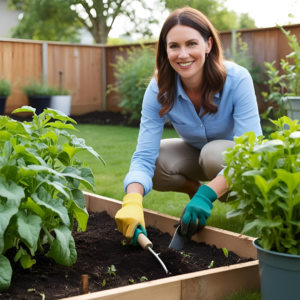Did you know that a well-designed outdoor space can boost your property value by up to 12.4%? Whether you have a small balcony, a cozy patio, or even just a windowsill, you can create a thriving garden that transforms your area into a lush retreat. I’ve always believed that patio gardening ideas can be a game-changer.
Choosing the right plant varieties is key. From vibrant flowers to fresh herbs, the options are endless. Pairing them with the right containers and a thoughtful design can make all the difference. I’ve found that mixing ornamental and edible plants not only looks stunning but also adds functionality to your outdoor space.
Adding pops of color and unique design elements can elevate your space. Whether it’s a vertical garden or a cozy seating area, every detail matters. My own journey has been inspired by experts like Bailey Nurseries and Ellen Ogden, who emphasize the beauty of small-scale gardening. I even used the ideas for my onion container gardening ideas.
Ready to turn your modest area into a green oasis? Let’s dive into the details and explore how you can make it happen.
Key Takeaways
- A well-designed outdoor space can increase property value significantly.
- Even small areas like balconies or patios can become thriving gardens.
- Choosing the right plants and containers is essential for success.
- Mixing ornamental and edible plants adds beauty and functionality.
- Creative design and color choices can elevate your outdoor space.
Designing a Functional and Aesthetic Patio Garden Layout
Designing an outdoor area that’s both functional and beautiful starts with understanding your space. Whether you have a small balcony or a larger area, the key is to maximize every inch. I’ve found that a thoughtful approach to layout can make even the most modest spaces feel like a lush retreat.
Assessing Available Space and Sunlight
Before you start, take time to evaluate your outdoor area. Measure the space and note how much sun it receives daily. Most plants thrive with six to eight hours of sunlight, so this is crucial for successful planting. I like to observe the area at different times of the day to see where shadows fall.
Grouping plants according to their light needs is a smart strategy. For example, place sun-loving plants in the brightest spots and shade-tolerant ones in cooler areas. This ensures every plant gets what it needs to flourish.
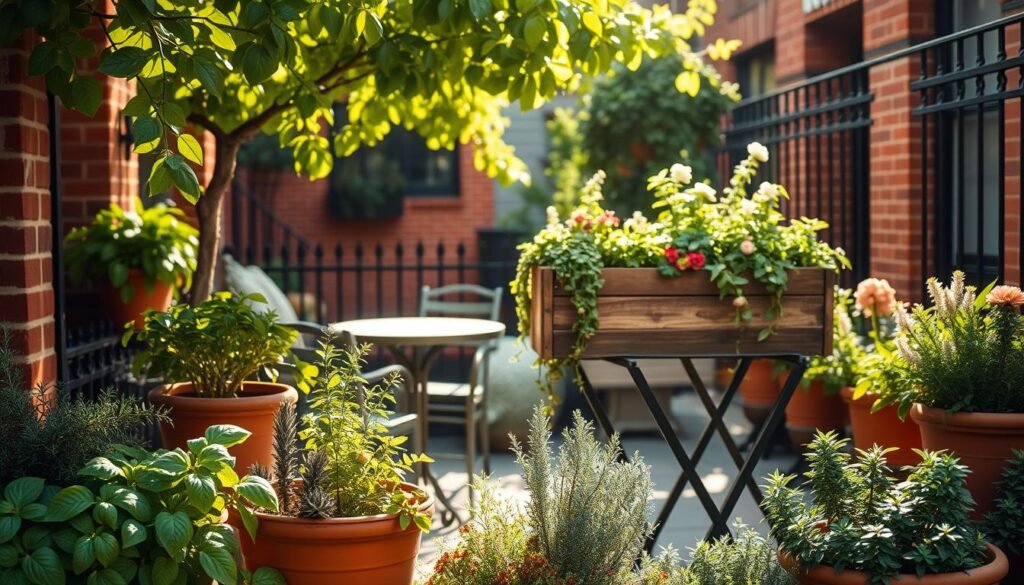
Mapping Out Garden Zones
Once you understand your space and sun patterns, it’s time to map out different zones. I like to divide the area into sections based on function. For instance, create a cozy seating nook, a vibrant flower bed, and a practical herb corner.
Using containers is a great way to define these zones. They allow you to move plants around and experiment with different layouts. Plus, they add visual interest and structure to your garden.
Don’t forget to consider water accessibility. Place plants that need frequent watering closer to a water source. This small detail can save you time and effort in the long run.
By balancing functionality and aesthetics, you can create an outdoor area that’s not only beautiful but also easy to maintain. A well-planned layout sets the stage for a thriving garden that you’ll enjoy all season long. It’s also a good idea when growing garden basket projects.
Maximizing Small Outdoor Spaces for Gardening
Even the tiniest backyard can become a vibrant garden with the right approach. Limited space doesn’t mean you have to compromise on beauty or functionality. With creative solutions, you can transform any compact area into a lush retreat.
Creative Solutions for Compact Areas
One of the best ways to maximize small spaces is by using containers and planters. They allow you to arrange plants in a way that suits your design and space. I’ve found that grouping pots of varying heights creates visual interest and makes the area feel larger.
For summer, choose plants that thrive in the heat and add pops of color. Herbs like basil and rosemary are perfect for small pots, while flowering plants like petunias bring vibrancy. I love mixing edible and ornamental plants for a functional yet beautiful garden.
When selecting pots, consider their size and placement. Smaller containers work well for herbs, while larger ones are ideal for shrubs or small trees. I’ve learned that arranging them in clusters creates a cohesive look and maximizes space.
Balancing aesthetics with practicality is key. For example, I use self-watering planters to save time and ensure my plants stay healthy. This approach has turned my small backyard into a thriving green oasis.
By experimenting with layouts and plant combinations, you can create a stunning outdoor area that feels spacious and inviting. With a little creativity, even the smallest spaces can bloom.
Choosing the Right Containers and Planters
The right container can make or break your plant’s health and growth. Whether you’re working with a small balcony or a larger outdoor area, selecting the perfect planter is essential. It’s not just about looks—functionality plays a huge role too.
Selecting Containers for Optimal Drainage
One of the most critical factors in choosing a container is drainage. Without proper drainage, excess water can lead to root rot and other issues. I always look for pots with holes at the bottom to ensure my plants stay healthy.
Material also matters. Unglazed terracotta pots allow for better airflow but dry out faster. Glazed or plastic planters retain moisture longer, which can be helpful in hot weather. For frost-prone areas, plastic or metal options are more durable.
Benefits of Self-Watering Planters
Self-watering planters are a game-changer, especially during busy weeks or hot summers. These systems use a reservoir to provide consistent water to the roots, reducing the risk of over or under-watering. I’ve found they’re perfect for herbs and vegetables that need steady moisture.
Another advantage is their efficiency. They help maintain the right soil moisture levels, which supports healthy root growth. Plus, they’re a great option for those who travel frequently or have limited time for daily watering.
When selecting a planter, consider both design and functionality. A well-chosen container not only enhances your space but also ensures your plants thrive. With the right setup, you can create a beautiful and low-maintenance outdoor area.
Selecting Plants Suited for Patio Gardening
Transforming your outdoor area starts with the right plant choices. Whether you’re working with a small balcony or a cozy corner, selecting the right varieties can make all the difference. I’ve found that a mix of herbs, vegetables, and flowers not only adds beauty but also functionality to your space.
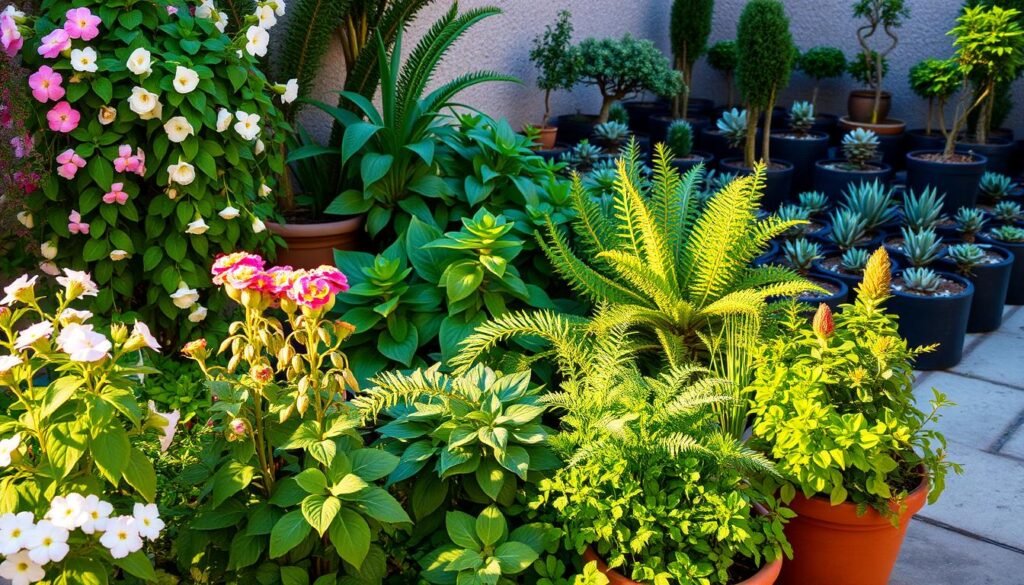
Herbs, Vegetables, and Flowers for Every Season
One of my favorite tips is to choose plants that thrive in different seasons. For spring, I love planting basil and parsley, which grow quickly and add fresh flavors to meals. Summer is perfect for cherry tomatoes and peppers, which thrive in the heat. In fall, I switch to kale and Swiss chard, which can handle cooler temperatures.
Flowers like petunias and marigolds add vibrant color throughout the year. I’ve learned that pairing these with edible plants creates a balanced and inviting space. Seasonal planting ensures your area stays lively and productive all year round.
Compact Varieties for Limited Space
When space is limited, compact plant varieties are a game-changer. Dwarf cherry tomatoes and petite basil are perfect for small containers. I’ve also had great success with dwarf sunflowers, which add height without taking up too much room.
Choosing the right container size is crucial. Smaller pots work well for herbs, while larger ones are ideal for vegetables like tomatoes. I always ensure proper drainage to keep my plants healthy. One unique idea I had was to use laundry baskets for gardening.
“The key to success is matching plant choices with container sizes and light conditions.”
By balancing culinary edibles with ornamental flowers, you can create a space that’s both beautiful and functional. With the right plants, even the smallest areas can feel lush and inviting.
Expert Patio Gardening Ideas for Small Spaces
Innovative solutions can turn even the tiniest areas into lush retreats. Over the years, I’ve learned that with the right strategies, compact spaces can thrive. One of my favorite approaches is using containers to maximize every inch. They allow flexibility in design and make it easy to rearrange plants as needed.
Seasoned gardeners often recommend grouping plants with similar needs. For example, place sun-loving varieties in the brightest spots and shade-tolerant ones in cooler areas. This ensures each plant gets the right amount of light and water. I’ve found this method particularly effective in my own small outdoor area.
Planning your planting schedule is another key strategy. Start with quick-growing herbs like basil and parsley in spring, then transition to heat-loving vegetables like tomatoes in summer. This keeps your space productive and visually appealing throughout the year.
“The key to success is matching plant choices with container sizes and light conditions.”
Finally, don’t underestimate the power of creativity. Vertical gardens, hanging containers, and tiered planters can add depth and dimension to your area. With a little planning and expert advice, even the smallest spaces can become vibrant, green retreats.
Cultivating Vibrant Colors and Textures
Color and texture are the heart of any visually appealing outdoor area. They bring depth and life to your space, making it feel inviting and dynamic. I’ve found that blending different plant varieties is the key to creating a stunning garden.
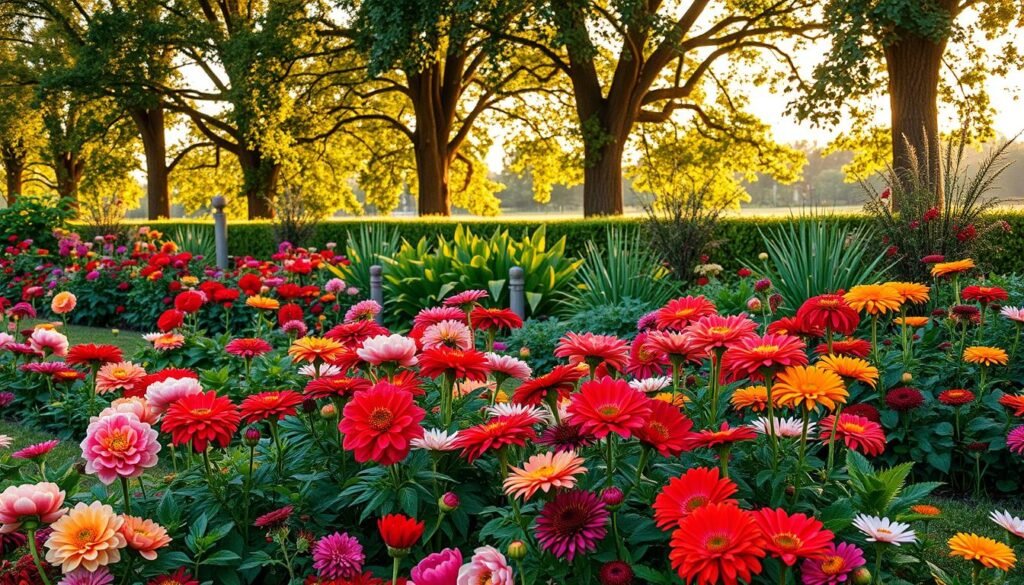
Mixing Plant Varieties for Visual Interest
One of my favorite strategies is combining plants with contrasting colors and textures. For example, pairing bold red flowers with soft green foliage creates a striking effect. I’ve also had success mixing ornamental grasses with flowering plants for added depth.
Here’s a simple table of plant combinations that work well together:
| Plant Type | Color | Texture |
|---|---|---|
| Petunias | Purple | Smooth |
| Lamb’s Ear | Silver | Fuzzy |
| Ornamental Grass | Green | Feathery |
When planning your garden, consider how colors interact. Warm tones like red and orange create energy, while cool blues and greens promote calmness. I often use a mix of both to balance the mood.
Texture also plays a big role. Plants with glossy leaves add shine, while those with rough or fuzzy foliage provide contrast. I’ve learned that layering these elements creates a rich, multi-dimensional look.
“The key to a vibrant space is balancing bold colors with complementary textures.”
Finally, don’t be afraid to experiment. I’ve had great results with unexpected combinations, like pairing vibrant marigolds with delicate ferns. With a little creativity, your outdoor area can become a masterpiece of color and texture.
Essential Watering and Soil Management Tips
Proper watering and soil care are the foundation of a thriving outdoor space. Without the right mix and techniques, even the most beautiful plants can struggle. I’ve learned that attention to detail in these areas makes all the difference.
Choosing the Best Potting Mix
The right soil is crucial for healthy growth. According to Ellen Ogden, a balanced mix ensures proper drainage and moisture retention. I always look for blends that include peat moss, perlite, and compost. These ingredients create a light, airy texture that roots love.
| Soil Type | Drainage | Moisture Retention |
|---|---|---|
| Peat Moss | High | Moderate |
| Perlite | Very High | Low |
| Compost | Moderate | High |
When selecting a mix, consider your plant’s needs. Succulents thrive in well-draining soil, while vegetables prefer moisture-rich blends. I’ve found that customizing the mix for each plant leads to better results.
Watering is equally important. I water deeply in the morning to reduce evaporation and ensure roots absorb enough moisture. For containers, I check the soil daily, as they dry out faster than ground plantings.
“The key to vibrant growth is balancing moisture retention with proper drainage.”
To maintain nutrient levels, I add compost every few weeks. This keeps the soil rich and supports healthy growth. Self-watering containers are another great option, especially for busy days. They provide consistent moisture and reduce the risk of over or under-watering.
By focusing on these essentials, you can create a thriving outdoor space that’s both beautiful and functional. With the right soil and watering routine, your plants will flourish all season long.
Season-Long Strategies for Patio Garden Success
Keeping your outdoor space thriving all year requires smart planning and adaptability. By focusing on the changing needs of each season, you can ensure your garden remains vibrant and productive. I’ve found that a little foresight goes a long way in creating a space that evolves beautifully throughout the year.
One of my favorite techniques is succession planting. This involves replacing early-season crops with those that thrive in late summer or fall. For example, I start with cool-weather vegetables like lettuce in spring, then transition to heat-loving tomatoes in summer. This maximizes your harvest and keeps your garden productive.
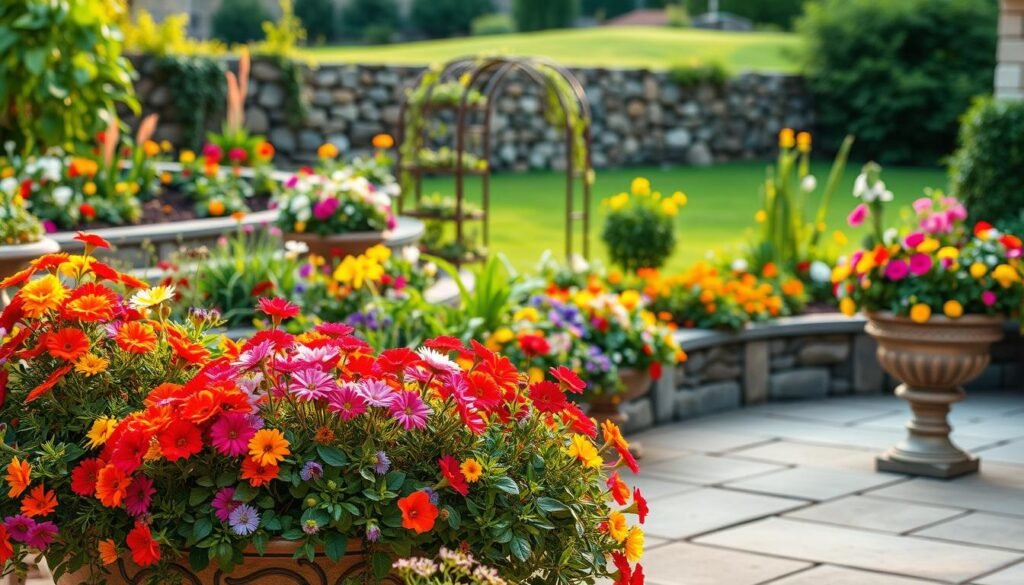
Rotating crops is another key strategy. It prevents soil depletion and reduces the risk of pests. I like to alternate heavy feeders like tomatoes with lighter ones like herbs. This keeps the soil healthy and ensures your plants get the nutrients they need.
As the seasons change, so should your design. In spring, I focus on colorful flowers and leafy greens. By summer, I switch to vibrant vegetables and heat-tolerant plants. Fall is perfect for cool-weather crops like kale and spinach. This approach keeps your space fresh and exciting.
“The key to a thriving garden is adapting to the needs of each season.”
Container arrangements also play a big role. I use larger pots for summer crops like tomatoes and smaller ones for herbs. This allows me to rearrange plants as needed and make the most of available sunlight. Self-watering containers are a great option for busy days.
Finally, don’t forget about sun exposure. Most vegetables need at least six hours of direct sunlight daily. I observe my space throughout the day to ensure each plant gets the light it needs. By following these strategies, you can create a thriving outdoor area that adapts to every season.
Incorporating Culinary and Ornamental Elements
Blending edible and ornamental plants creates a space that’s both beautiful and functional. I’ve found that combining culinary herbs with decorative flowers not only enhances the design but also adds practicality to your garden. This dual-purpose approach allows you to enjoy fresh flavors while surrounded by vibrant colors.
Growing Edible Plants in Your Outdoor Space
One of my favorite ways to maximize a small area is by using containers. Herbs like basil, rosemary, and thyme thrive in pots and add a fresh touch to meals. Pairing them with ornamental flowers like petunias or marigolds creates a stunning visual contrast. I’ve found that this combination works well in any home setting.
Seasonal vegetables like cherry tomatoes are another great addition. They grow well in larger pots and provide a tasty harvest. I like to place them near aromatic herbs like oregano, which enhances their flavor naturally. This approach not only saves space but also creates a cohesive design.
Here are some benefits of growing edibles alongside ornamentals:
- Fresh ingredients right at your fingertips.
- Aesthetic appeal with vibrant colors and textures.
- Efficient use of space with containers and vertical arrangements.
Companion planting is another strategy I use. For example, pairing basil with tomatoes improves growth and flavor. This method reduces pests and promotes healthier plants. I’ve found it to be a game-changer in my own garden.
“The key to a thriving space is balancing beauty with functionality.”
Finally, don’t be afraid to experiment. I’ve had great success with unexpected combinations, like mixing lavender with rosemary. This not only looks stunning but also attracts pollinators. With a little creativity, your outdoor area can become a haven of flavor and beauty.
Innovative Planters and Self-Watering Systems
Innovative planters and self-watering systems are transforming how we care for plants, making it easier to maintain a thriving outdoor space. I’ve experimented with modern container technologies and found that they not only save time but also enhance plant health. These systems are especially useful during peak heat, ensuring your plants stay hydrated without constant attention.

One of my favorite design features is the self-watering planter. These containers have a built-in reservoir that provides consistent water to the roots. This is a game-changer for busy days or when you’re away from home. I’ve used them for herbs and vegetables, and they’ve kept my plants healthy even during the hottest months.
Another great idea is using color-coordinated planters to create a cohesive look. I’ve paired green containers with vibrant flowers for a striking contrast. Hanging planters are also a fantastic option for small spaces, adding depth and visual interest to your design.
“The key to success is choosing a planter that balances aesthetics with functionality.”
Here are some benefits of using innovative planters:
- Reduced water waste with efficient self-watering systems.
- Improved plant health by maintaining optimal moisture levels.
- Enhanced design with stylish and functional containers.
For those who travel frequently, self-watering systems are a lifesaver. I’ve tried the wick method, which uses cotton rope to draw water from a bucket into the soil. It’s simple yet effective, especially for multiple plants. Commercial options like watering globes are also convenient and easy to use.
Finally, don’t overlook the importance of design. A well-chosen planter can become a focal point in your outdoor space. I’ve found that layering containers of varying heights creates a dynamic and visually appealing arrangement. With the right tools and a little creativity, you can elevate your outdoor area to new heights.
Vertical Gardening and Hanging Planters
Vertical gardening is a game-changer for small spaces, offering both beauty and functionality. By using walls and hanging structures, you can transform even the tiniest areas into lush retreats. I’ve found that this approach not only maximizes space but also adds a unique aesthetic to any outdoor area.
Utilizing Wall Space Effectively
One of the best ways to maximize a small balcony or outdoor area is by using wall space. Vertical gardens allow you to grow plants upward, saving valuable floor space. I’ve used trellises and modular planters to create a cascading effect that looks stunning and keeps plants healthy.
When planning a vertical garden, consider the amount of sunlight your wall receives. Most plants need at least six hours of sunlight daily. I’ve found that grouping plants with similar light needs ensures they thrive. For example, place sun-loving varieties at the top and shade-tolerant ones below.
Modern Ideas for Suspended Gardens
Hanging planters are another fantastic option for small spaces. They add depth and visual interest to your design while keeping plants off the ground. I’ve experimented with different materials, from macramé hangers to sleek metal containers, and each adds its own charm.
Here are some modern ideas for suspended gardens:
- Use tiered planters to create a layered look.
- Combine herbs and flowers for a functional yet beautiful display.
- Incorporate self-watering systems for low-maintenance care.
“The key to a successful vertical garden is balancing aesthetics with practicality.”
Finally, don’t forget about design elements. I’ve used light and color to accentuate vertical structures, creating a dynamic and inviting space. With a little creativity, even the smallest areas can become vibrant green havens.
Incorporating Artful Accents into Your Outdoor Space
Adding artful accents to your outdoor space can elevate its charm and personality. I’ve found that small, thoughtful touches can transform an ordinary area into an inviting retreat. Whether it’s a decorative box or a textured planter, these elements add depth and character to your garden.
One of my favorite ways to enhance a space is by playing with color and texture. Contrasting materials like smooth stone and rough wood create visual interest. I’ve used colorful hanging baskets to draw attention and add pops of color that stand out from a distance.
Decorative boxes and planters can serve as focal points. I’ve repurposed old birdbaths into succulent planters, which not only look stunning but also add a touch of creativity. Mixing traditional and modern elements, like pairing vintage boxes with sleek metal planters, creates a balanced design.
Integrating sculptures or artful objects can also make a big impact. I’ve used handmade stepping stones decorated with ceramic tiles to add a unique touch to the ground. These DIY projects are affordable and add a personal flair to the space.
“The key to a memorable outdoor area is blending functionality with artistic expression.”
Here’s a simple guide to mixing textures and colors effectively:
| Element | Texture | Color |
|---|---|---|
| Planters | Smooth | Neutral |
| Stepping Stones | Rough | Vibrant |
| Decorative Boxes | Wooden | Earthy |
Experimenting with different mixes can lead to surprising results. I’ve combined lush greenery with bold sculptures to create a dynamic look. The key is to let your creativity guide you and not be afraid to try new ideas.
Finally, don’t overlook the ground. Adding textured pathways or gravel areas can enhance the overall design. I’ve used artificial grass between pavers for a low-maintenance yet stylish finish. With these tips, your outdoor space can become a true reflection of your personality and style.
Personal Reflections on My Patio Gardening Journey
Over the years, my journey with transforming my outdoor space has been filled with both challenges and rewarding moments. What started as a simple idea to add greenery to my home evolved into a vibrant garden that brings me joy every day. Along the way, I’ve learned valuable lessons that have shaped my approach to design and plant care.
Lessons Learned and Favorite Designs
One of the biggest lessons I’ve learned is the importance of patience. Not every plant thrives immediately, and some require adjustments to their environment. For example, I initially struggled with sun-loving varieties in shaded areas. Moving them to sunnier spots made all the difference.
Experimenting with different designs has been one of the most enjoyable parts of this journey. I’ve found that mixing textures and colors creates a dynamic look. My favorite addition has been a vertical garden using hanging planters. It not only saves space but also adds depth to the room.
“The key to success is trusting your instincts and being willing to adapt.”
Another lesson I’ve embraced is the value of simplicity. Early on, I tried to incorporate too many elements, which made the space feel cluttered. Now, I focus on a few key pieces that complement each other. This approach has made the garden feel more cohesive and inviting.
Looking back, I would have invested more in self-watering systems from the start. They’ve been a game-changer for maintaining healthy plants, especially during busy weeks. This small addition has made a big difference in the overall success of my garden.
My journey has taught me that gardening is as much about creativity as it is about care. Every design choice, from plant selection to container arrangement, reflects a piece of my personality. I encourage anyone starting their own journey to trust their instincts and experiment freely. After all, the best ideas often come from trial and error.
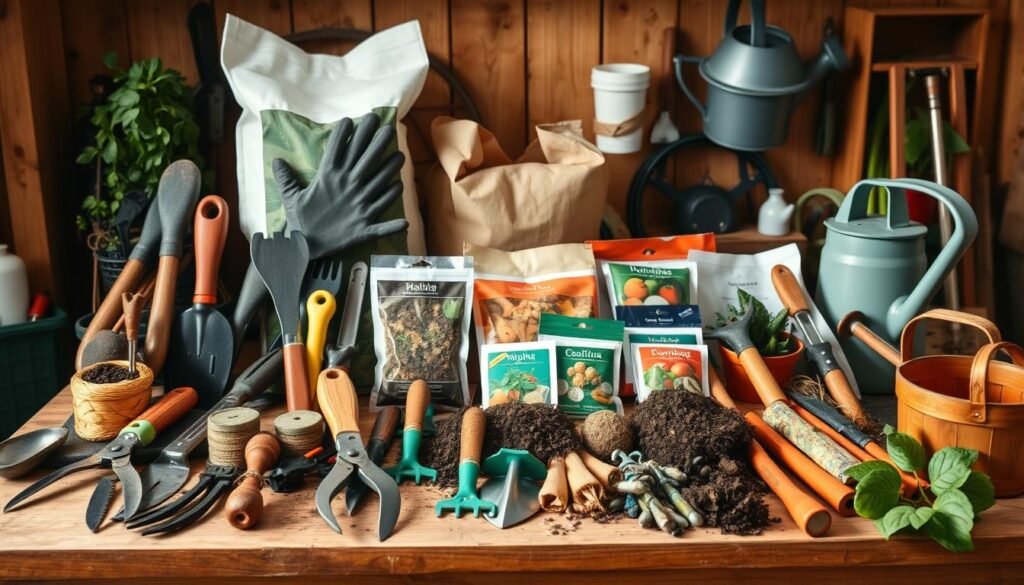
Sustainable Practices for Long-Lasting Gardening
Creating a sustainable garden not only benefits the environment but also ensures long-term success for your plants. By adopting eco-friendly practices, you can reduce waste, conserve resources, and enjoy a thriving outdoor space year after year. I’ve found that small changes can make a big difference in the health of your garden.
Eco-Friendly Gardening Solutions
One of the easiest ways to start is by choosing sustainable containers. I prefer using recycled materials like wood or bamboo, which are both durable and environmentally friendly. These options not only look great but also reduce the need for new plastic containers.
Another key practice is using a high-quality soil mix that promotes healthy growth. I like to add compost to my soil, which enriches it naturally and reduces the need for chemical fertilizers. This approach keeps my plants healthy while minimizing environmental impact.
Water conservation is also essential. I’ve switched to self-watering systems that ensure my garden gets just the right amount of moisture without waste. Pairing this with drought-tolerant plants has made my outdoor space more resilient, especially during dry spells.
Here are some additional tips for sustainable gardening:
- Use native plants that thrive in your local climate.
- Compost kitchen scraps to create nutrient-rich soil.
- Incorporate companion planting to naturally deter pests.
“Sustainable gardening is about working with nature, not against it.”
Finally, thoughtful design can enhance sustainability. I’ve arranged my garden to maximize sunlight and airflow, which reduces the need for extra watering and pest control. By adopting these practices, you can create a beautiful, eco-friendly space that thrives throughout the year.
Blending Design Elements for a Cohesive Outdoor Look
Creating a cohesive outdoor look starts with blending design elements seamlessly. Whether you’re working with a small balcony or a larger area, the key is to balance colors, shapes, and textures. I’ve found that a thoughtful approach to design can transform any space into a harmonious retreat.
Harmonizing Colors and Shapes
One of the most effective ways to create a unified look is by harmonizing colors and shapes. I like to use a neutral base, such as grays or browns, and add pops of vibrant color with flowers or decorative planters. This approach ensures the space feels balanced and inviting.
Grouping plants by shape also adds structure. For example, tall, spiky plants like ornamental grasses pair well with rounded shrubs. I’ve found that this combination creates visual interest without overwhelming the design.
Here’s a simple guide to blending colors and shapes:
| Element | Color | Shape |
|---|---|---|
| Flowers | Vibrant | Rounded |
| Grasses | Neutral | Spiky |
| Planters | Earthy | Geometric |
Another tip is to incorporate natural elements like wood or stone. These materials add texture and warmth, enhancing the overall design. I’ve used wooden boxes for herbs and stone pathways to create a cohesive flow.
“The key to a unified space is balancing bold elements with subtle accents.”
Finally, don’t be afraid to mix modern and traditional options. For example, I’ve paired sleek metal planters with vintage ceramic pots. This blend of styles adds depth and personality to the garden.
By experimenting with different combinations, you can create an outdoor space that feels both cohesive and uniquely yours. With a little creativity, your home can become a true reflection of your idea of beauty.
Grow Your Patio Garden Today
Transforming even the smallest outdoor area into a lush retreat is easier than you think. By using creative container solutions and thoughtful planning, you can create a thriving garden that adapts to every season. Whether it’s a sunny balcony or a shaded corner, the right plant choices and sustainable practices can make all the difference.
Expert tips from Bailey Nurseries and Ellen Ogden remind us that even limited spaces hold immense potential. Vertical arrangements and self-watering systems are game-changers, especially during the hot summer months. These innovations not only save space but also ensure your garden stays healthy with minimal effort.
My journey has taught me that experimentation is key. Don’t be afraid to mix edible and ornamental plants or try new ideas. Every container and every vegetable you grow adds a personal touch to your space. Start small, trust the process, and watch your outdoor area blossom into something truly special.
FAQ
How do I start designing my patio garden layout?
Begin by assessing your available space and sunlight. Map out zones for different plants based on their needs, ensuring a functional and aesthetic design.
What are some creative solutions for small outdoor spaces?
Use vertical gardening techniques, hanging planters, and compact plant varieties to maximize limited areas without sacrificing beauty or functionality.
How do I choose the right containers for my plants?
Select containers with proper drainage to prevent waterlogging. Self-watering planters are a great option for consistent moisture levels.
Which plants work best for patio gardening?
Herbs like basil, vegetables like tomatoes and peppers, and flowers like petunias thrive in containers. Choose compact varieties for smaller spaces.
How can I add vibrant colors and textures to my garden?
Mix different plant varieties with contrasting colors and textures. Combine flowering plants with leafy greens for visual interest.
What’s the best way to manage soil and watering?
Use a high-quality potting mix and water consistently. Self-watering systems can help maintain optimal moisture levels, especially during hot summer days.
How do I incorporate edible plants into my patio garden?
Grow herbs, vegetables, and fruits in containers. Tomatoes, peppers, and herbs like rosemary are excellent choices for a culinary garden.
What are some innovative planter ideas?
Try vertical planters, wall-mounted boxes, or hanging baskets to save space and add a modern touch to your outdoor area.
How can I make my patio garden more sustainable?
Use eco-friendly practices like composting, rainwater harvesting, and choosing native plants to reduce your environmental impact.
What’s the key to a cohesive outdoor design?
Harmonize colors, shapes, and textures. Add artful accents like decorative pots or garden sculptures to tie everything together.

